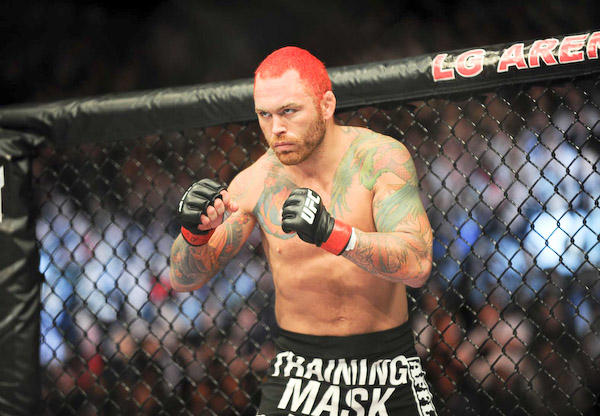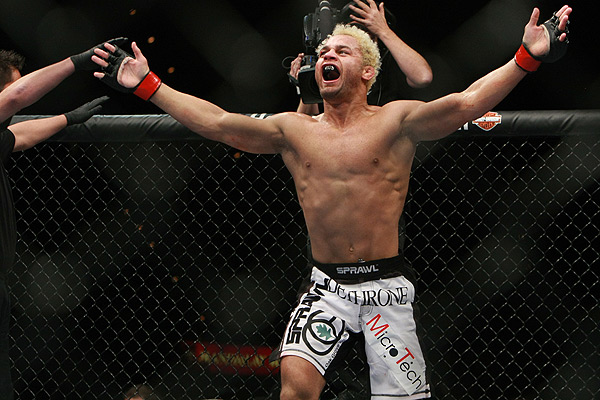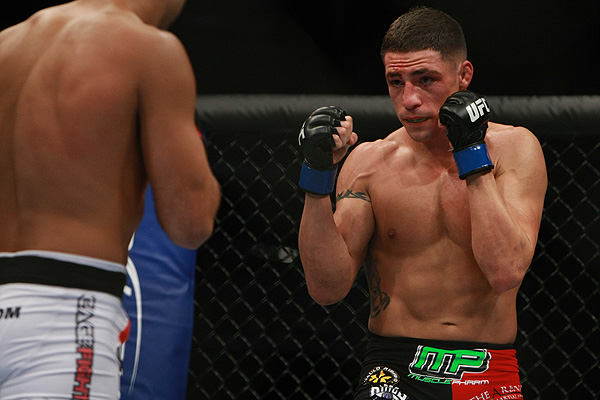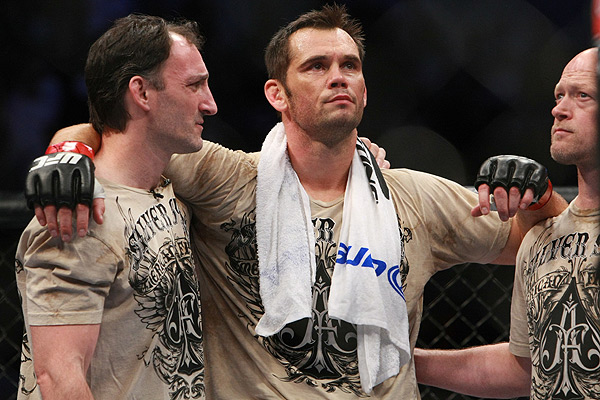An Enduring Legacy: ‘The Ultimate Fighter 1’ Finale

Ten
years have passed since Forrest Griffin and Stephan Bonnar engaged
in their historic battle. | Photo: Jeff Sherwood
The Ultimate Fighting Championship on Thursday will mark the 10th anniversary of “The Ultimate Fighter 1” Finale. It is certainly not an event that has faded from the public imagination with time. Quite the contrary, it has been built up into one of the most iconic and important events in the history of the sport. Yet, the magic of that legend has both illuminated and obscured the event itself. People remember the visceral excitement of Forrest Griffin and Stephan Bonnar’s thrilling brawl, but so many of the details surrounding the buildup to and fallout from that fight remain hazy if not completely misremembered. It manages to be simultaneously very well-remembered and very poorly remembered from a historical standpoint.
The legend of the show is well-known. The UFC was still a relatively unproven television entity with an uncertain future. Then Griffin and Bonnar entered the Octagon. Word of mouth spread in the midst of a classic fight. Viewership grew to 10 million viewers. Spike TV decision makers decided to offer the UFC a second season of “The Ultimate Fighter” reality series and pay for the show this time around. The UFC was on its way.
Advertisement
Related » Breen & Mindenhall Discuss the 10-Year Anniversary
In reality, “The Ultimate Fighter” was a big hit long before the finale. A second season was already greenlit. The highest rating for the show was actually for the Josh Koscheck-Chris Leben fight, even with the inclusion of a Ken Shamrock-Rich Franklin main event. Viewership for the finale, while exceedingly strong in the target demographics, was a solid but unspectacular 2.6 million in total. As a television-ratings vehicle, it was a success but not a game-changer.
It was, however, a game-changer in a number of other ways.
To begin with, the first “Ultimate Fighter” finale likely affected
the career trajectories of a number of key fighters. When Griffin
and Bonnar engaged in their classic brawl, it was a triumph for the
two men, as well as the promotion and fans. If there were any
losers in the equation, it might have been their fellow “Ultimate
Fighter” compatriots. The stars of the first season remain
well-remembered by fans, even 10 years later, but Griffin and
Bonnar have come to define Season 1, something that would have
seemed unlikely to viewers who watched the reality show up to that
point.
For most of the first season of “The Ultimate Fighter,” Griffin and Bonnar were background players. Griffin’s most notable moment might have been acting like a monkey and mashing a banana into his own face. The stars of the show were Leben, Koscheck and Bobby Southworth. The rivalry and eventual fight between Koscheck and Leben was what led to increased ratings; it was the focus of the television audience. However, after the show concluded, Griffin became the primary beneficiary of “The Ultimate Fighter” hype. Koscheck and Leben enjoyed long and successful careers of their own, but their historic rivalry and importance to the sport would become somewhat forgotten over time.
Part of that was understandable. The story of two fighters showing tremendous heart and engaging in a great battle makes for a much better seminal moment in a sport’s history than a drunken fighter breaking a door after being sprayed with a hose or a fighter calling another a “fatherless bastard.” Additionally, Leben and Koscheck fought in different divisions and were rarely ever discussed as potential opponents. However, as Leben and Koscheck move past their fighting careers, they do so without the full level of credit they deserve in their sport’s rise in popularity.
The same could be said for Diego Sanchez. When the fighters were announced for “The Ultimate Fighter 1,” Sanchez was the man with the most buzz. The undefeated King of the Cage champion backed up that hype in the cage, winning all four of his fights, with three first-round stoppages. Griffin surged past Sanchez in popularity after the finale, and Sanchez never caught up. Like Leben and Koscheck, Sanchez has been very successful in the Octagon over the years but definitely is considered a secondary figure on a show he dominated more than any other.
Even Franklin, the future middleweight champion, might have been hurt a little by the success of Bonnar-Griffin. Franklin’s dominant technical knockout win over Shamrock in the main event of that show was the highest-profile victory of his career to that point. It was supposed to be a star-making performance that would help to turn Franklin into one of the UFC’s signature pieces. However, even before Franklin lost to Anderson Silva, he did not click with fans the way Chuck Liddell, Randy Couture, Tito Ortiz, Matt Hughes and others did, and his fights were rarely big hits on pay-per-view.
It is not as if Franklin’s story would have been completely different were it not for Griffin and Bonnar. However, his fight with Shamrock was unquestionably an afterthought when most any other night it would have been a focal point. A year later, Franklin was middleweight champion, but he never fully captured the public’s imagination. Shamrock, meanwhile, went on to break MMA pay-per-view and television records. It probably would not break his heart if fans forgot he was on the card for “The Ultimate Fighter 1” Finale.
Individuals might have been overshadowed in the excitement of that finale, but the general excitement of the event had the effect of providing credibility to fighters coming off the show. While new viewers were invested in the antics and personalities of the reality television stars, it was no guarantee that fans would accept them as competitors on the level of current UFC standouts. Skepticism quickly flew out the window when their debuts on live television produced explosive, star-making performances. “The Ultimate Fighter” was not a gimmick, and fighters coming off the show have impacted the sport in big ways ever since.
Beyond the way it altered the courses of individual careers, Griffin-Bonnar helped to shape the identity of a still-young sport. It feels so much more a part of modern MMA than Gerard Gordeau-Teila Tuli, but in 2016, Griffin-Bonnar will be as close in time to UFC 1 as it is to present day.
Fighters have grown up and evolved, with that bout put forward as the exemplar of what MMA is all about. It is not an exaggeration to say that card and that fight changed the way the sport is fought.
Prior to the first “Ultimate Fighter” finale, the fights perceived to be the best in UFC history were largely tactical affairs. Frank Shamrock-Ortiz was a dramatic triumph of conditioning and heart over size and power; and Couture-Pedro Rizzo was a back-and-forth struggle with each man looking to impose his type of fight on the other. They were exciting fights, but they were a different template than the wild brawls that generally defined Pride Fighting Championships, such as Don Frye-Yoshihiro Takayama and Wanderlei Silva’s wars with Hidehiko Yoshida and Quinton Jackson.
Pre Bonnar-Griffin, UFC fighters rarely threw strategy out the window in order to entertain fans with out-of-control offense. The sport was in most instances about imposing your style on your opponent, even if that meant a less exhilarating battle. Since Bonnar-Griffin, it is much more common to see fights where both fighters just bite down on their mouthpieces and swing. From Liddell-Wanderlei Silva and Sanchez-Karo Parisyan through Dan Henderson-Mauricio Rua and Mark Hunt-Antonio Silva, fighters have followed the successful example of Bonnar and Griffin and looked to ride excitement to bonus money and greater fan recognition.
Compared to boxing, which prioritizes the ethic of winning above all else, MMA celebrates putting on a show. The UFC has done all it can to encourage that trend, and the most seminal moment in that long-term trend was the conclusion of the first season of “The Ultimate Fighter.” The story of Griffin-Bonnar was that both fighters were winners because they put on a crowd-pleasing fight. Providing a memorable fight could often prove more beneficial to one’s career than winning, something that had been true in Japan but not in America until that specific point.
Of course, there are downsides to that approach. While Couture was once celebrated for his wrestling dominance, Ben Askren is now exiled. Great wrestlers like Johny Hendricks and Daniel Cormier often rely on striking.
If the goal of MMA is to prove what would work best in a real fight, that is perverted to some degree when the game is rigged to emphasize more exciting techniques. The glorification of wild brawls is central to that evolution.
The emphasis of offense over defense also leads to fighters taking more punishment. Griffin and Bonnar throughout their careers as crowd-pleasing fighters took so much more damage than more defense-minded fighters like Georges St. Pierre and Anderson Silva. Bonnar-Griffin glorified courageously taking punishment, an attitude that is fan-friendly but not good for a competitor’s health.
For better and worse, the MMA we love today is strongly and permanently imprinted with the legacy of the first “Ultimate Fighter” finale. Mixed martial arts is the sport of that event. Some of the specifics may be misremembered and forgotten, but its big-picture significance is most assuredly not overstated.
Related Articles











